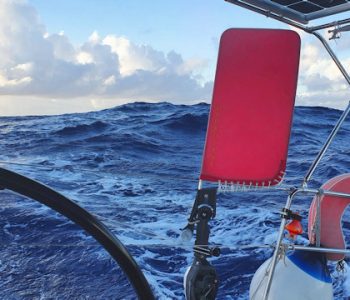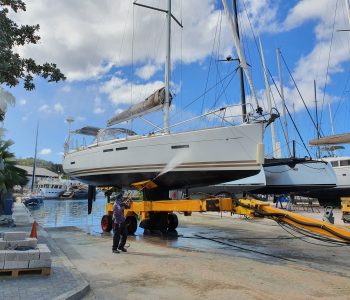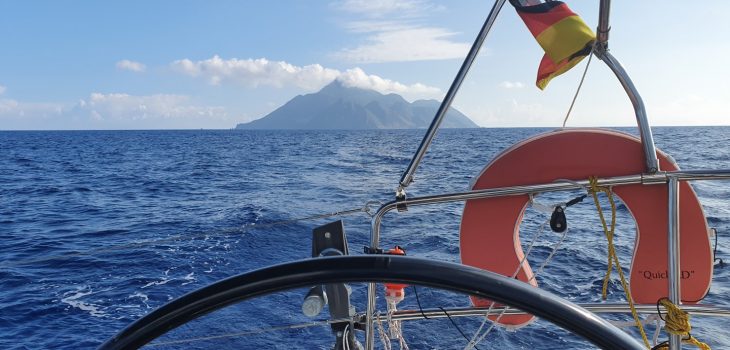 Allgemein
Allgemein
Across the Caribbean Sea
Now it is time to cross the carribiean sea together with Stefan. When we arrive in Curaçao after making stops in Saba and Bonaire, not only this trip ends, but also the first stage of my circumnavigation.
Arrival of Stefan
On January 24th I made my way to the dinghy bar late in the morning. Here I used the WiFi to update the weather data and blog entries until Stefan arrived. Shortly after 3 p.m. the time had come. We hadn’t seen each other for a long time. I’ve known Stefan since the early 2000’s. We have already sailed together with our skipper Michael.

After the welcome beer we went to the Aurelia. She was still well-behaved in the Simpson Bay. The 25 kg Rocna kept her stable in position despite strong winds, gusts and waves from three different sides.



Maho-Beach
Of course, we cannot leave Sint Maarten without visiting Maho Beach again. So we hiked on January 25th from the dinghy dock to the end of the runway. The atmosphere there can best be described with a few pictures and a landing video:






A jet taking off had a surprise ready. The otherwise deafening sound of the motors completely stops when you stand directly behind them. At first I wondered why the pilot was taking off the gas. Shortly afterwards I felt the exhaust pipe on my chest. If you start a jumbo you should even be able to blow in the water. Unfortunately only smaller planes took off today.
26.1. – Let’s go to Saba
Next morning we went ashore one last time. Stefan bought a few more food while I cleared out – this time according to the regulations. Then it already started. Of course not without a last rain shower.
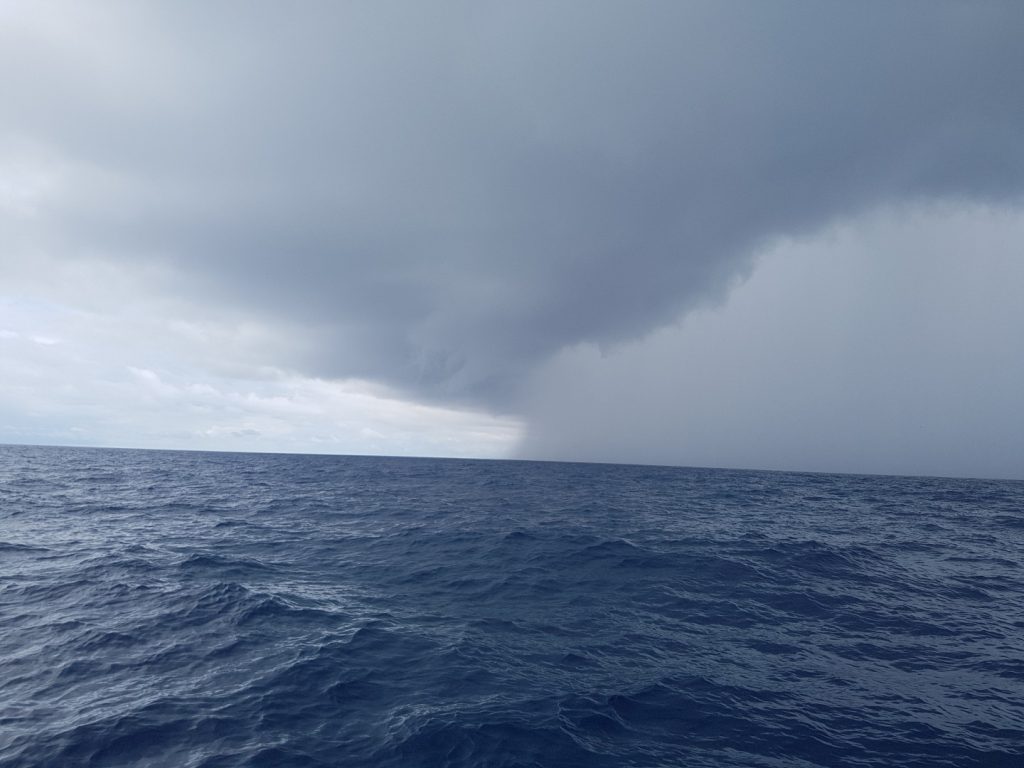



The island of Saba, just 25 nautical miles from Sint Maarten, arises steeply from the sea. It only has a small port for fishing boats and ferries. Anchoring is prohibited. Few mooring buoys make it possible to stay. In front of the harbor none was left, so we grabbed the last free buoy in Ladder Bay and used the evening before the multi-day crossing to swim, chat and sleep in.
I felt kind of weird though. Like I have a cold. Everything smelled and tasted boring. I spent most of the night in the on-board toilet.
Saba Bank
On the morning of the 27th we started right after breakfast. While I had to bend over the Rehling once or twice, we sailed over the Saba Bank at a gentle 3-5 knots. It is a huge area with a white sandy bottom. On average, the bank is only 20 to 30 meters deep. But not everywhere. Some places are much flatter. Fortunately, our map was accurate enough. After one last rain cell, the weather finally improved. This was unfortunately accompanied by lull. After a magnificent sunrise over the mercury-looking Caribbean, sailing was impossible. We had to use the iron jib to get pushed.





Dolphins
Next night we could sail again. Just before my wach I checked the Foredeck.
The next night we could sail again. Shortly before my watch I checked the fore deck one more time. That’s how I got used to it on the Atlantic. Not in vain! The shekel with which the genoa is attached to the boat had come loose. It now threatened to tear down below. Stefan seemed quite amazed how I could find something like that in the middle of the night. It was fixed quickly and I took the second watch. The next day we were once again accompanied by dolphins for a long time. Always beautiful:

Until January 31st it was a quiet, almost comfortable crossing for the two of us. The second biggest excitement was failed speedometer. Something was caught in the sensor. Stefan tried a short drive backwards and lo and behold, it ran again. Who would have thought that.


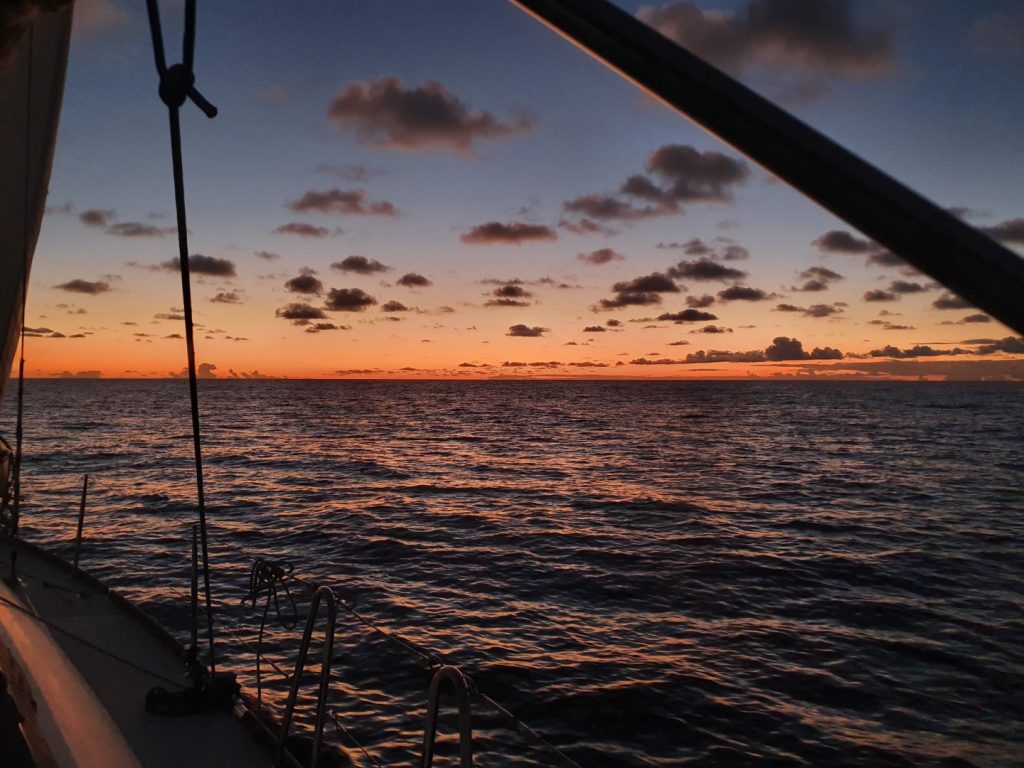
Bonaire
Then we came near Bonaire. The wind picked up, and so did the traffic. A tanker came quite close to us, so we decided with him over the radio who was going to take which side. You have the right of way with a sailing yacht, but you shouldn’t rely on it when a 250 meter long steel colossus stomps towards you. Shortly after 2 pm we reached Bonaire’s buoy field. Actually an ideal time to find a free buoy. But today some fishing event took place here. The marina was full and the only free buoy was so close to land that my sonar sounded the alarm. Since the display shoes less than 2 meters, I didn’t want to get any closer to the buoy, even if Stefan could almost grab it. If we were to swing around the buoy later, touching down on the bottom would be entirely possible.
So we had no choice but to sail on to Curacao. That gnawed a bit at the mood, which we improved with a delicious dinner on slow sailing speed. I was pretty tired. So Stefan took over the watch and only woke me shortly before Curaçao. We chose the first anchorage we found – Fuik Bay. Fortunately, the visibility was good enough to see that the buoy system B, which is prevalent throughout America, is not used in Curaçao. Here, as almost everywhere else on earth, buoy system A applies. Means, the green buoys are on starboard and the red buoys are on port when driving towards the coast. In system B, the shapes are the same, but the colors are swapped.
Coast Guard on Board
Fuik Bay is well protected but rarely visited. Probably because its entrance is “adorned” by a local phosphorus mining plant.
After the morning exercise and piece, we made our way to clearing in at Willemstad. The capital is located south of the Shottegat, a large bay. In this by are the natural harbor, a marina with dry dock and workshops, but also customs, immigration and port authorities. In order to be granted entry, you have to call the port. He then opens the famous pontoon bridge at a suitable time.
That was our plan too. Unfortunately we weren’t allowed to enter and were told to sail to “Spanish Water” – the southern bay of Curaçao. We should anchor there without a permit and take a taxi back to Willemstad.
The Seru-Boca-Marina is also in Spanish Water. I have reserved a berth there for the next few weeks. I’m pretty sure that once I get there, I won’t leave anytime soon. So we relaxed and sailed further north to the beautiful Santa Cruz Bay. Unfortunately, the coast guard arrived at the same time. We didn’t want to anchor illegally right in front of their eyes, so we hesitated until they let their speedboat off the leash and visited us with 5 men. After extensive checks and questioning, we were allowed to stay in the bay until Monday.
So anchor down and into the crystal clear water. The keel hovered about a meter above the bottom. The blue here is amazing. I wouldn’t be surprised if there are umpteen different words for turquoise in Papiamentu – the local language.








We enjoyed the weekend in the bay, visited the beach with his somewhat weird but very kindly Captain Goodlife. His “crew” started the grill especially for us and served us a great meal.
Seru Boca Marina
On Monday morning we made our way back. Against the wind it was far less pleasant than on Saturday. Back in Willemstad we were again denied entry, so we went to the Seru-Boca-Marina – the final destination of the first stage. The entrance to Spanish Water is quite narrow and peppered with flat spots. The Santa Barbara Beach & Golf Resort is on the starboard side, along with a jetty for small and large yachts, a white sandy beach, a beach bar and 18 golf courses.
After we meandered around a peninsula with holiday apartments, we moored in the Seru-Boca-Marina. It’s not very big and quite remote if you rely on public transport. But it is very quiet and safe here. Robert, the manager of the marina, was already on the jetty and helped us with mooring.





Now it is history, the first stage of my circumnavigation. We started in Locmiquelic about 120 days ago. A total of 19 crew members accompanied me for about 6200 nautical miles. We were at sea for 74 days. We went to 40 marinas and bays and had seen a lot.
But now I need a rum first.
Willemstad
Immediately after mooring, we made our way to clearing in. We went to Willemstad by minibus. The Odyssey took its course. You feel like you are the first sailing ship to ever call at the island. Customs was easy to find with its big letter on the roof. Unfortunately, the building was closed for renovation and customs de facto moved unknown.
So we went to immigration. This office is on the other side of the bay in the port area, which you can only enter with a pass. This was issued quickly. The port office is right next to Immigration. You are not allowed to register here without a customs confirmation. So back to customs. After we asked about the replacement location, it was already 4:45 pm – Customs closes at 5:00 pm. No reason to open the door for us again. The dushi life is not an issue but we don’t want to stay illegal on the island.
We left without having achieved every thing and used the next morning to do the rest of the formalities.
Close to customs, we were impressed by the 92-meter-yacht Tatoosh, lying on the quay. It belonged to the late Microsoft co-founder Paul Allen. Can you still have fun with a yacht of this size? For Sure as a guest, but as an owner? Depressing for me: The Tatoosh has a sailing yacht as a dinghy. At 12 m, it is just as long as the Aurelia.

After the formalities were done, we spent the rest of the day in the surprisingly beautiful city.




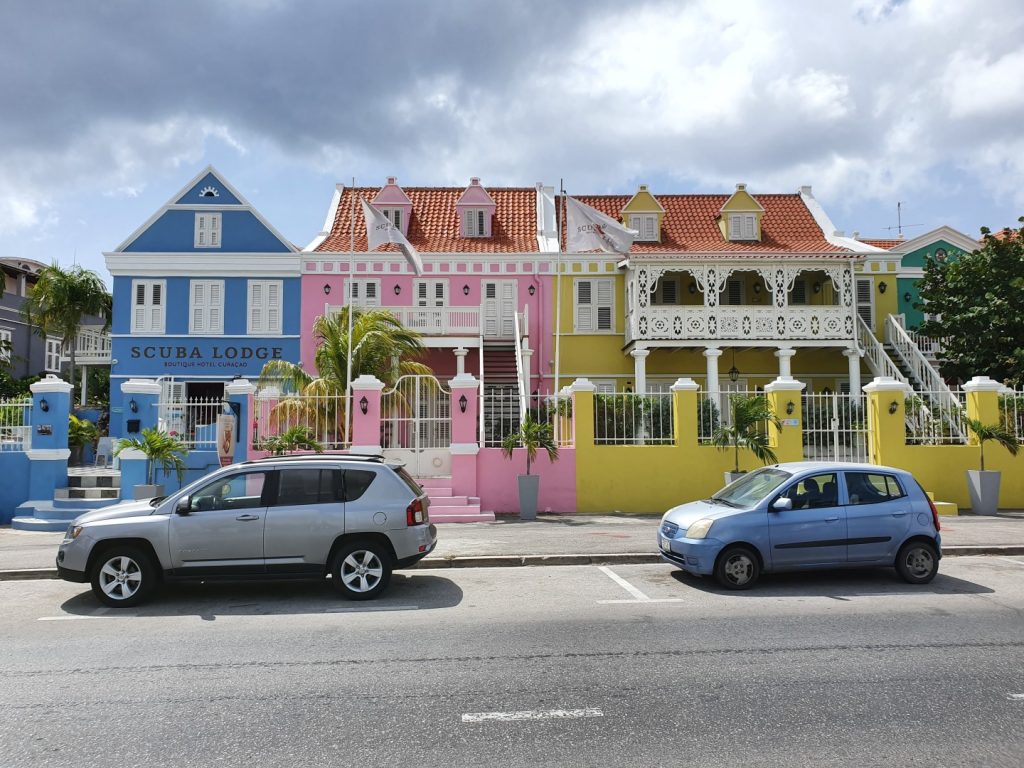



Farewell
After another “Dushi Day” on Curacao it was time to say goodbye. The two relaxing weeks with Stefan were over quickly.



